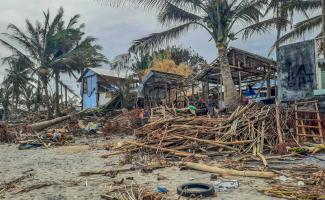Insurance
Managing climate risk with private insurance

It is estimated that weather disasters claimed more than 1 million people’s lives in the years 2000 to 2018. In the same period, the financial damages amounted to $ 4.21 trillion (Aon 2018). Since the turn of the millennium, the harm done by natural disasters and dangerous weather has increased substantially. Since 1980, however, a mere 30 % of the damages have been insured.
The lack of insurance coverage is particularly evident in developing countries and emerging markets. On the one hand, they are especially exposed to the impacts of global warming, both in regard to the frequency and intensity of extreme weather. On the other hand, many people simply do not buy insurance coverage so far (see Dirk Reinhard on www.dandc.eu).
Since 1980, less than five percent of weather damages have been insured in Asia, excluding Japan. The UN Development Programme (UNDP) estimates that only about three percent of disaster damages were covered by insurances in the 77 poorest countries. The implication is that the countries and people concerned must bear the costs of relief and reconstruction themselves, unless they can rely on international aid.
Comprehensive risk management is needed. Apart from adaptation to climate change and better disaster preparedness, climate-risk insurance must become an important component of such management.
Regional, national, international
There are different kinds of climate-risk insurance, starting with micro-insurance policies for individual persons. However, regional, national and international schemes exist too (regarding the difference between governmental social protection and private insurance, see Markus Loewe on www.dandc.eu). Disbursements can be triggered in different ways:
- Indemnity-based insurance covers losses that actually have occurred.
- Index-based insurance covers expected damages that are believed to be likely to coincide with specific weather data. If the wind exceeds a certain strength, for example, or if there is no rain in a predefined time period, the insurance company disburses a certain amount of money.
Climate-risk insurances have been attracting considerable attention in recent years. There are many meaningful examples (see box). Nonetheless, many obstacles still prevent insurance coverage from becoming the default situation in low-income countries. Many of them are not climate risk specific, but generally apply to the insurance business in markets that are marked by low purchasing power (Reinhard 2019).
Considerable obstacles
A core challenge is that conventional insurance corporations, for cost reasons, typically do not show much interest in reaching out to the lowest income groups. The lower premiums and disbursements are, the more relevant transaction costs become. Moreover, both distribution and client-account management tend to be very difficult, and that is especially the case in rural areas, where power supply and intranet access are often unreliable, if they are available at all.
Infrastructure problems of this kind make it hard to assess damages fast after extreme-weather events, and disbursing money is difficult too. The issue is not quite as relevant for index-based insurances, but they have downsides too. For example, the index often only roughly coincides with actual damages, so the people concerned sometimes do not get an adequate insurance payment, or maybe even none at all.
It also matters that insurance companies must make substantial investments if they want to offer clients good solutions. Considerable market research is needed. The companies must develop a deep understanding of how people live and what their financial situation is like. Crucial issues include:
- How are the most important risks currently being managed?
- What additional service can an insurance company provide?
Finally, the companies need clients who understand how insurance works. That cannot be taken for granted, especially when someone signs an insurance contract for the first time.
Governments that are interested in climate-risk management could similarly benefit from improved insurance literacy. Bureaucrats’ understanding of the advantages and disadvantages are not always up-to-date. In the lack of important information, approaches to risk management sometimes remain suboptimal. Insurance companies can contributing to raising more awareness by providing data and models.
Yet another challenge is that insurance companies require reliable statistics – regarding both weather and damages – in order to accurately assess what risks they are covering. Statistics, however, tend to be poor in low-income countries. Adding to the problems, the climate crisis is escalating fast, so weather-induced harm has become worse than in the past – and it is occurring more frequently.
For all these reasons, climate-risk insurances are quite expensive. Oftentimes, they require subsidies. That applies to the countries concerned as well as the low-income groups who live there.
Digitisation helps
Digitisation offers considerable opportunities, however, and the Covid-19 pandemic has accelerated the trend. Mobile phones and mobile-payment systems have been spreading fast even in rural areas of developing countries. As a result, data has become more easily available, the flow of information has become faster, and the costs of the insurance business have gone down. It would make sense to reform regulations in ways to support innovation.
According to the Intergovernmental Panel on Climate Change, 3.3 billion to 3.6 billion people are vulnerable to global warming. In view of the serious impacts of the climate crisis, insurance coverage must improve fast. Governments, the insurance industry and international institutions should cooperate better to make that happen. If they join forces, they can make insurances a core component of adaptation strategies.
References
Aon Weather, Climate & Catastrophe Insight 2018 Annual Report:
http://thoughtleadership.aon.com/Documents/20190122-ab-if-annual-weather-climate-report-2018.pdf
Reinhard, D., 2019: Making insurance work for emerging economies. South African Actuary, April 2019.
Renate Bleich is the chief executive of Munich Re Foundation.
rbleich@munichre-foundation.org
Dirk Reinhard is her deputy at Munich Re Foundation.
Christian Barthelt is a senior project manager at Munich Re Foundation.








